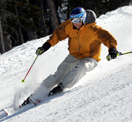HighAngles: Your binding position is still the same and the sidecut is still in the same place, but you no longer have much tip on the ground until you are fairly edged.
This makes sense to me! And since we are all about tipping to develop our turns, I have to believe that the compromise is minimal, especially for an "all mountain ski" that aspires to be jack of all trades, but master of none.
Float and Velocity and Equipment Choices
36 posts
• Page 3 of 3 • 1, 2, 3
Re: Float and Velocity and Equipment Choices
Early rise and reverse camber skis, are like trying to drive a car with the steering on the back wheels.
-

h.harb - Posts: 7047
- Joined: Sat Feb 03, 2007 2:08 pm
- Location: Dumont, Colorado
Re: Float and Velocity and Equipment Choices
Wow, good thing I was busy all day yesterday and missed this. I can speak for the early rise skis that I have skied and very simply there is no there there (speaking of the tips). Because it doesn't exist there is nothing to pressure. Again bringing things back on topic, from a PMTS perspective, you are taking away an essentiall part of PMTS skiing which involves feet pullback and early tip pressure at the top of every turn. I think the only thing that I would say is that small amounts of early rise are not nearly as bad for your PMTS technique as tail rocker. It is also clear that if you can ski with any speed and velocity in powder, you don't need early rise at all.
Balance: Essential in skiing and in life!
-

jbotti - Posts: 2187
- Joined: Fri Nov 28, 2003 10:05 am
Re: Float and Velocity and Equipment Choices
Learning to ski with the traditional methods, from wedge transition to parallel for a skier makes about as much sense; as learning to drive on the right side of the road (left steering wheel) and than being sent to Ozz or Britain, to be a taxi driver.
-

h.harb - Posts: 7047
- Joined: Sat Feb 03, 2007 2:08 pm
- Location: Dumont, Colorado
Re: Float and Velocity and Equipment Choices
John speaks with experience, listen to him, or you will wasting lots of time and money on dysfunctional equipment..
-

h.harb - Posts: 7047
- Joined: Sat Feb 03, 2007 2:08 pm
- Location: Dumont, Colorado
Re: Float and Velocity and Equipment Choices
Skiasaurus Rex wrote:Interesting discussion thus far.
The appeal of the early rise is the possibility of skiing a narrower ski than traditional fat skis as a dedicated powder, soft, deeper crud snow ski. I don't know if this translates into reality, but the idea of the design has some appeal.
Even in powder, I don't always like the the lag time between edges and the torque on my knees of a fatter ski (fat being 105mm or higher. I ski on a traditional camber 110mm ski in softer, deeper snow). But it's a trade off I-and most people, even on this forum-make to get the advantages of float. Yes, Jbotti's idea of mastering the skills to be able to ski at 'terminal velocity' in powder makes float on a narrower ski more possible. However, does a narrower , say 88-98mm waisted ski with early tip rise that will be used as a quiver ski focused on deeper snow (crud and powder) offer no advantages-especially for someone who wants help in the float at less than terminal velocity department but also wants a ski that is quicker edge to edge (with less knee pressure) than a fatter traditional camber ski?
I skied the Rossi Experience 88 and 98 last year in different conditions and liked them, but I didn't get enough time on them to really assess their strengths and weaknesses.
I don't have the answer to this-it's an open ended question to skiers here who have experience with all sorts of designs and a better grasp of ski physics than I.
I wanted to add to my above thoughts...Of course an early rise tip isn't touching the snow on hard snow-that is inarguable. But I thought the point of the design was about what it offered in Soft and deeper snow. Do the tips encounter snow in soft and deeper conditions, and if they do, do they respond to tip pressure (while giving some protection against tip dive and some added float?)?? Which brings me back to the above questions-If you are looking for a narrower soft/ deeper snow ski (over a traditionally cambered fatter ski), and your intent of use is soft/ deep snow, does early rise with camber under foot offered any advantages?
Like I said, I don't have enough experience with these designs to make a learned assessment. I can say, I like the few designs I've tried over the older 'rocker' designs.
- Skiasaurus Rex
- Posts: 172
- Joined: Mon Feb 21, 2011 6:18 am
36 posts
• Page 3 of 3 • 1, 2, 3
Return to Primary Movements Teaching System
Who is online
Users browsing this forum: Majestic-12 [Bot] and 30 guests
